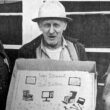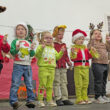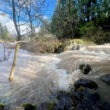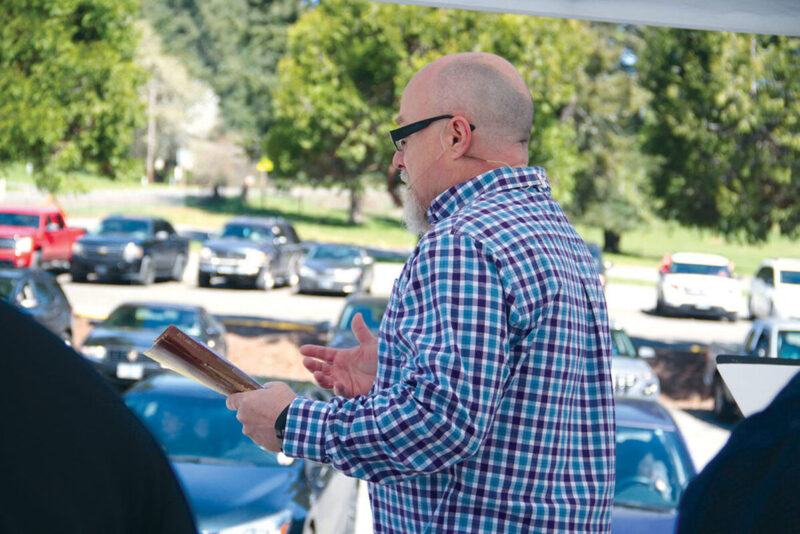Sean C. Morgan
Those horns blaring in Holley Easter Sunday morning no doubt got neighbors’ attention.
But the clamor was simply Holley Christian Church congregants making a joyful noise as church members honked their horns rather than uttering the string of “amens” or clapping that may be heard in church sanctuaries during normal worship services.
Holley Church had already put modern technology to use prior to the outbreak of COVID-19. Since the order banning large gatherings went into effect, it’s continued to take advantage of the Internet in communicating with its membership.
But the church went old-fashioned on Easter Sunday, with the venerable drive-in theater as a model.
Members and visitors pulled up in their cars and turned their FM radios to 102.5 to hear Pastor Kevin Hill and the worship team in three half-hour church services on the church’s brand new gravel parking lot.
The church wasn’t serving popcorn and soda, Hill said, but “people can bring their own popcorn if they want to.”
This was among a variety of ways, most of them using the Internet, that churches are still serving their members despite the social distancing Americans are using in an attempt to slow the spread of COVID-19.
In the case of Holley, Hill said the church recently expanded its parking lot, and one of the members remembered his father attending a drive-in church established by Robert Schuller, founder of the Crystal Cathedral in Garden Grove, Calif., in the 1960s.
Hill decided he would preach where the movie screen would be located after preaching an indoor service.
Holley tried it a week earlier as a practice run for Easter, Hill said. Drivers were routed through the entrance on Old Holley Road and guided into parking spaces by parking attendants. Hill and the worship team used a flatbed trailer.
“It’s safer than Safeway,” Hill said. “Because you don’t get out of your vehicle. Nothing in or out. We want to worship, but we want to keep everybody safe.”
The parking lot was fullest during the earliest service, 9:30 a.m. and sparsest during the 11:30 a.m. service on Easter.
Prior to that service, Holley has maintained an online presence, with a live stream on Facebook and the service posted later to YouTube and the church website. Regular service times are 10 a.m. and 6 p.m. on Sunday.
Right now, the church is working on streaming live right through its website, Hill said.
“There’s been a lot of real fast change.”
Pastors across Sweet Home reported a growing number of people attending church since going online live.
A lot of that includes clicks from people who don’t continue watching, Hill said, but “it is more. I know it’s more because people are inviting people that don’t even live here.”
Holley has had viewers in Texas, California and other states, he said. “It seems easier for people who aren’t used to going to church. It seems easy for our people to invite them. I don’t know if it’s the novelty of it.”
Holley Church had already been filming and posting services later in the day prior to COVID-19 crowd restrictions, Hill said, but up until that point, the church hadn’t been doing live services online.
“We worked 15-hour days to get it out,” he said, and that was to maintain the connection among the members of the congregation.
He doesn’t much like the term “social distancing,” Hill said. That way leads to suicide and drinking. Rather, it’s just “physical distancing. We’re staying connected.”
The technology isn’t anything new. The Church of Jesus Christ of Latter-Day Saints has been taking advantage of long-distance communications for years, using satellite communications and the Internet. In the past year, it has specifically developed a program to deal with a situation just like this one.
“Our church and its membership have been well-prepared specifically for something like this,” said Bishop Ivan Wolthuis. Last year, the church implemented “home-centered, church-supported worship” in which church leaders provide direction to parents to provide at-home services to their families. Normally members of the congregation lead services, and the local church is not streaming live services to members.
In 2018, Wolthuis said, the church restructured the way the way it ministers to members to serve them both spiritually and temporally, in the physical realm, relying on leaders to make contact with families to ensure those needs are met.
The Mormon church has a lot of material available online already, Wolthuis said, and where necessary, the church is using the Internet to meet. Last week was the church’s worldwide general conference. The conference center in Salt Lake City, Utah, can accommodate thousands, but the president and church leadership spoke to an empty room and cameras.
“They all sat 6 feet apart from each other,” Wolthuis said. “It was as uplifting and meaningful as ever” and a “very special experience.”
He believes the congregation is maintaining its participation levels, Wolthuis said, but “the missionary work has been heavily curtailed.”
The church has recalled thousands of missionaries, who normally serve a two-year mission, releasing some early and assigning others in their home countries.
The mission work continues online, Wolthuis said. That’s something the LDS church started in 2013.
“I truly think that things were inspired,” he said. “When it comes to this pandemic, we were largely prepared for it.”
Other churches have had online presences while others have retooled quickly to take advantage of modern information technology to varying degrees.
Holley was already there, but live-stream services are new.
“Churches are like schools and government,” Hill said. “Our church moved pretty rapidly, actually, because we can. This has gotten the church doing what we should’ve been doing.”
Similarly school districts have had to radically alter how they operate to keep kids in front of a teacher using hardware and software technology that’s been available for years. Today, in Sweet Home, they’re spending several hours a day doing school work. Local government agencies are videoconferencing and teleconferencing more and handling more work electronically.
Sweet Home Schools Supt. Tom Yahraes has recognized the distance learning as an opportunity, another tool in the district’s box.
It’s the way the world works now, Hill said. The world is a seamless combination of the digital and physical.
“Wise churches will recognize that and continue to thrive,” he said, noting that Holley integrated the digital component about 10 years ago.
But the physical is just as important as ever.
“The old school is new school again,” Hill said. The church just held a drive-in service, after all, but additionally, he is making more voice phone calls rather than texting and messaging these days as a way to connect personally – hearing someone’s voice is a personal connection.
Not everyone is well-connected digitally either.
Sweet Home Evancelical Church Pastor Brian Hotrum was out Good Friday afternoon, delivering Easter baskets to families with children.
“You’ve got to do something like that,” he said.
Hotrum isn’t doing a live stream to a sanctuary filled with stuffed animals, which are visible in a video posted to Facebook, he said. “I’m pre-recording. I don’t really have all the equipment to do live.”
He is posting the services to YouTube and Facebook. He’s finding extra views, but he can look at analytics and see the average length of time people watch.
“What I do know is the people in church appreciate it,” he said.
As digital as things are, “I’ve got people who aren’t on the Internet,” Hotrum said. He burns CDs and delivers those to those folks. Others may not have a computer and Internet connection, but they’ve got phones, and he can text a YouTube or Facebook link.
All in all, he’s staying busy, he said. He is on the phone constantly.
“If you’re a good pastor, you’re busier now than you were before,” Hotrum said.
Moving forward, he’s curious how COVID-19 will affect society, going forward. Previously, if a meeting or service used 80 percent of the seating capacity, it was considered full. People don’t like “to sit on top of each other,” he said. He’s wondering if that number will fall to 60 percent or something even lower as people want even more space around them.
At Harvest Christian Center, “it’s crazy,” said Pastor Mark Woody. “That’s for sure. We’re doing everything online, which is working for us because we have a good audio-visual department.”
Woody said he records his sermons early, and then the worship team comes in and records, with the service going online Sunday.
“We’ve got about 95 percent of our church folks to record themselves saying, ‘Happy Easter,'” he said. Those recordings have been stitched together to create a video and posted to YouTube and Facebook, where they can see each other.
The church leaves copies of the sermon in envelopes for pickup by the elderly who are not connected, he said. He estimated that about 90 percent of the congregation is tuning in online to watch.
Woody said a lot of pastors are delivering their sermons in a chair – and he does too for the Wednesday service, which is something he sometimes does anyway – but on Sundays “I stand up and preach just like if it was a house full of people. This is not going to defeat us.”
The coronavirus experience has changed things, he said. “We believe once we get to come back together because we have been able to advance our online presence, we’ll maintain an online presence. We look at it as a blessing.”
Even a physical ceremony like communion can work at a distance. Woody said that two weeks ago, the church delivered pre-filled communion cups and wafers, allowing the entire church to remotely participate in communion together.
“It’s not ideal, but we’re going to use it to our advantage and move for the Lord,” he said.
At Hillside Fellowship, “for the last couple weeks, I’ve been doing a little devotional on video,” said Pastor Matt Coleman. “Our children’s ministry has done that too.”
The videos are posted to Facebook and YouTube, the devotional on Sunday and the children’s program on Wednesday.
For Easter, the church set up the 14 stations of the cross, Coleman said. People were able to walk through it – while keeping to themselves and not touching anything in order to maintain social distancing.
Five churches within the denomination record four minutes of the Luke 24 story of Jesus Christ’s resurrection, Coleman said. Crawfordsville Community Church Pastor Brian Huchings spliced those together to create a 20-minute Easter video.
The church board has been meeting using Zoom and, going forward, the church is considering the idea of a Bible study on Wednesdays and looking for additional venues for services.
Coleman is maintaining close contact with his congregation through a text app, FlockNet, which allows him to text everyone in the church, to share announcements and prayer requests, while maintaining a connection and letting them know he’s thinking of them and hoping they’re doing well.
Church leaders call members of the congregation to check in on them while they’re hunkered down at home, Coleman said, although about three-fourths of those who work are still working.
“We’re partners with Hope Church in Albany, same church, different campus,” said Pastor Mark Opperman of Hope Church, Sweet Home. “We’re all online”
The church offers its services in real time at 9 a.m. and 10:45 a.m. with “rewinds” at 6 p.m. on Sundays and a Tuesday meeting at 7 p.m.
During each of the four meetings, pastors are on social media ready to pray and talk with people who need it, Opperman said. He is trying to offer more video devotionals, four times a week.
Also, the food pantry continues to operate, Opperman said. Hands are sanitized and everything is pre-boxed for clients picking up food. Food pantry staff take the boxes outside to clients.
Opperman said quite a few more people are tuning in to services, people from all over the country.
“It seems like we’re touching a lot more people than we ever did,” he said. “In some ways, I’m busier than I ever was. At the same time, we’re trying to embrace this opportunity, encouraging people and reaching more than we ever have.”
River of Life Fellowship services are live on Facebook at 10 a.m. every Sunday, said Pastor Colton Emmert. The church’s website has a podcast as well.
Like other churches, the service is getting more views than the usual, Emmert said, and that’s encouraged him to make it a lasting change.
“We’ll have an online presence from now on,” Emmert said. “We’ll do live services.”
Noting that the COVID-19 outbreak has driven the church to adapt, “we’re not heading into the future,” Emmert said. “We’re just catching up. We’re getting it figured out. We’re connecting with more people than we ever have.
“It’s weird not connecting in person. The one thing I really worry about is people becoming isolated. (But) it’s been really cool that more people are hearing the Gospel. We’re seeing God move. It’s just different than we’ve ever experienced.”





